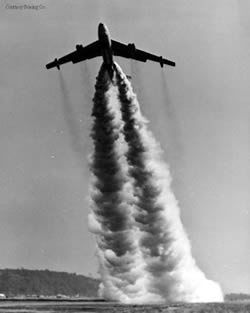
Lesson Twenty-three:
The Impact of the Cold War on Washington, an Overview
Left: Boeing stratojet XB-47 on its maiden test flight. (Special Collections, University of Washington. Photo courtesy of Boeing.)
It is a commonplace among historians of the Pacific Northwest that the Second World War marks the most important turning point in the region during the 20th century. It is less widely appreciated that the four-plus decades of mobilization for the Cold War, from roughly 1946 to 1990, perpetuated the influence of war and federal intervention on regional society, and in many cases accelerated or broadened those changes initiated between 1940 and 1945. In effect, the United States remained mobilized for war, and engaged at an entirely new level of international relations, not for four or five years—the time between Pearl Harbor and Nagasaki—but for roughly fifty years, from the onset of World War Two in 1939 until the fall of the Berlin Wall in 1989. In the state of Washington alone, one need only think about the rise of Boeing as the leading private employer and backbone of the Puget Sound economy; the continued expansion, production, and pollution occurring at Hanford; the kinds of international-relations activities reshaping the University of Washington into a major, public, research university; or the skyrocketing numbers of immigrants from around the Pacific Rim, to appreciate fully the importance of the Cold War to the Pacific Northwest. The following two lessons focus on a couple of examples of Cold-War influence on the Evergreen State—the developments surrounding Hanford, which produced plutonium for America's nuclear arsenal, and the Seattle world's fair of 1962, which gave urban expression to the Cold-War themes of space and science. This lesson offers an overview of the influence of the Cold War on Washington.
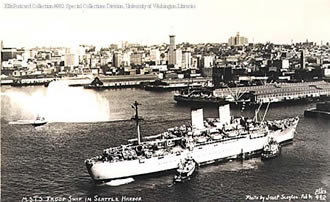
An MSTS troop ship in Seattle Harbor (right). (Special Collections, University of Washington, Ellis Postcard Collection, Photo #992. Photo by Joseph Scoylea.)
In emphasizing the experiences of Washington, we are considering the northwestern state where the Cold War had its greatest impact. Idaho and Oregon were also affected, of course, but a variety of factors combined to ensure that Washington would become substantially more mobilized than the other two states. One was the power of Washington's Congressional delegation in the nation's capital. Because the Evergreen State has had a larger population than either the Gem State or the Beaver State, its 20th-century Congressional delegation has been bigger, giving it more clout. Moreover, as pointed out in Lesson 19, Washington's U.S. Representatives and Senators after 1932 were usually aligned with the prevailing Democratic Party in Congress, and they also gained a surprising amount of seniority. Both relative advantages heightened Washington's ability to lobby successfully for Cold-War-related federal spending. There was also the matter of geographical good fortune. Contrasted to the other states, Washington had more physical features to attract defense-related activity. Puget Sound was a better harbor for such things as nuclear submarines and naval ships than anything Oregon could provide, and the fact that the Columbia flowed more through Washington than through Oregon gave the Evergreen State an "advantage" (if one can call it that now) when it came to placing nuclear reactors at Hanford.
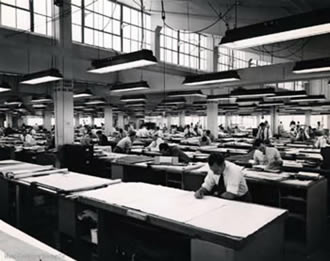
Boeing engineering (left): Cold War military contracts also impacted the employment of civilians, as this room full of Boeing engineers documents (Special Collections, University of Washington, neg. #10704. Photo courtesy of Boeing.)
Luck came in other forms, too. William Boeing, founder of the aerospace company, happened to be a Washington rather than an Idaho or Oregon timber baron. Finally, Washingtonians "made" their own luck through incessant boosting, lobbying, and promoting at the city and state level. Recognizing the value of defense-related spending to their communities, they ensured that Uncle Sam spent inordinate sums on air force bases, bombing and gunnery ranges, naval facilities, forts, and military-related industry in their state. [This hustling began long before World War Two. Tacoma, for example, lobbied and donated land in order to have Fort Lewis established next door in 1916-1917. See Jane T. Merritt, "Fort Lewis: Evolution of a Landscape," Columbia, the Magazine of Northwest History 5 (Winter 1991/2): 27-32.
Taken together, the various factors resulted in Washington becoming substantially more mobilized than its neighbors, including British Columbia. Compared to Oregon, Washington received about three times more military contracts from the federal government during one stretch of the Cold War; Oregon also ranked 48th of the 50 states in number of people employed in defense-related industry. Idaho's and Oregon's economies remained much more dependent on extractive industry, while Washington's became more dependent on manufacturing and services and was no longer so tied to lumber or other extractive industry. In this respect (and consequently in many others), Washington came to resemble California more than it did the states that bordered it. Its economy was generally more diversified, more reliant on federal spending, and more technologically oriented because of the importance of science, space, and engineering to Cold-War mobilization; its employees also received higher wages, on average. Such differences were not due entirely to the effects of the Cold War on the state, but the Cold War contributed to them significantly. The state experienced some sharp downturns in the post-war period, but in general the era brought considerable prosperity.
The economic upswing of the years after 1945 surprised many. During World War Two, Washingtonians were leery of the number of newcomers because they worried that the Depression would return at the end of the war and that there would not be enough jobs or public-assistance funds to go around. Thus, as mentioned in Lesson 20, Governor Langlie urged the Army to send the construction workers at Hanford, and "particularly the negroes," back home when the plant was built; thus, as mentioned in "The Exile and Return of Seattle's Japanese" by Roger Daniels, some labor organizations and farmers opposed the return of interned Issei and Nisei to the Puget Sound area in 1945. When the federal government began cutting back on war-related contracts, the hard times seemed imminent. At the peak of production, shipyards in the Portland-Vancouver area had employed 100,000 people; on August 1, 1945, that number had already dropped to 65,000. Portland's payroll had topped $44 million in 1943; by 1947 it had fallen to $18 million. Some predicted that Boeing's post-war employment would be no more than 10-15% of its wartime figure. People recalled the confusion, labor unrest, and recession after World War One, and worried that they would have to endure the same conditions in the mid-1940s.
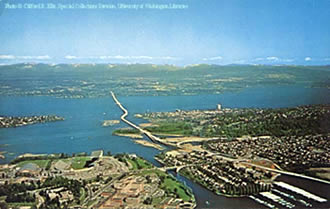
One result of pent-up demand for new housing was the increased suburbanization of Puget Sound cities. The completion of the Evergreen Point Floating Bridge (right) across Lake Washington is one symbol of this trend for Seattle. (Special Collections, University of Washington, Ellis Postcard Coll., Photo #C-684. Photo by Clifford B. Ellis.)
The economic transition was not, however, as traumatic as people had feared. There was significant unemployment in 1946, but it diminished substantially. Federal measures, such as the G. I. Bill which provided money for tuition and guarantees for housing mortgages, kept conditions from becoming worse. Many servicemen went straight from the military to college; the University of Washington doubled its enrollment from 7,000 in September, 1945 to 14,000 in September, 1946, and then expanded further to 16,650 by the next autumn quarter. Moreover, the pent-up demand for new housing—and consumer goods in general—was unprecedented, and wartime savings as well as veterans' benefits enabled that demand to be filled. As construction boomed in the region and across the country, the lumber industry began depleting the Northwest timber supply. The Gifford Pinchot National Forest in southwestern Washington offers a good example. In the decades leading up to World War Two, loggers had taken, on average, about 8 million board feet of timber annually from the forest. Then, turning increasingly to trees on publicly owned land, the lumber industry geared up to meet the vastly expanded demand for wood products that arose during and especially after the war. By 1947 the Gifford Pinchot National Forest was producing 100 million board feet annually; by 1959 its production reached the clearly unsustainable rate of 436 million board feet. Such figures promised long-term economic and environmental consequences, but in the short term they helped to underwrite economic expansion.
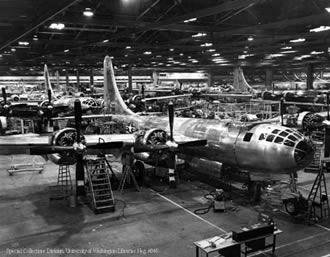
The assembly plant for the Boeing B-50 (left). (Special Collections, University of Washington, neg. #346. Photo courtesy of Boeing.)
A major reason why economic demobilization after World War Two went so smoothly was that it was less a transition from wartime to peacetime than a transition from one wartime economy to another—that of the Cold War. After a downturn in military spending in later 1945 and in 1946, the United States consistently enlarged its investment in national security beginning in 1947, with bursts of dramatic increase, such as during the Korean War, that mobilized the economy for defense purposes at a very high level. The state of Washington was on the receiving end of a great deal of this spending. It either acquired or expanded its defense establishment so that from the 1950s to the 1990s it possessed the Hanford complex; air force bases in Spokane and Tacoma; naval facilities on Whidbey Island and at Bremerton, Everett, and other locales; Army posts at Fort Lewis and elsewhere; plus a host of shipyards, other industrial concerns, and university facilities enlisted in Cold-War-related work.
The emergence of Boeing as the state's largest private employer epitomized the influence of the Cold War on Washington's economy. In 1962, one economist summarized the relationship between the company and the region: "As goes Boeing, so goes the Puget Sound region." This does not strike us as remarkable today, for most of us have grown up with the knowledge of Boeing's crucial role in Washington. But it is a remarkable statement when one notes that as late as 1939 there was no optimism that aircraft manufacture would become a major part of the regional economy. World War Two changed things, but could not by itself make Boeing into a mainstay. Work at the airplane manufacturer contracted sharply in 1946 and 1947, with its workforce falling from around 50,000 during the war to 9,000 afterwards. Local politicians and businessmen lobbied to have the federal government reinstate the aircraft orders that it had canceled, but to no avail. So Boeing, and the economy of greater Seattle, stagnated during 1946.
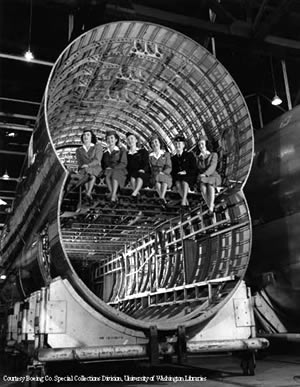
Boeing Stratocruiser (right). "Stewardesses 'model' their new stratocruiser," claimed a Boeing press release for this photograph. The view illustrates that employment opportunities were not just limited to men. Other photographs of this series also show women working on the construction line. (Special Collections, University of Washington. Photo courtesy of Boeing.)
Events in 1947 and after precipitated the global polarization between the United States and Soviet Union that became the Cold War. And over time the United States made substantial commitments to air power and nuclear weapons as staples for its military in the post-1945 era. But it was not automatic that the government would decide to procure hundreds of bombers; once the decision was made to buy bombers, it was not automatic that the government would buy the bombers from Boeing; and once the decision had been made to buy bombers from Boeing, it was not automatic that the new planes would be built in the Seattle area (Boeing also had plants in Wichita, Kansas). The health of Seattle's post-war economy depended at least in some part on each of these decisions; for that reason, Washington politicians and Puget-Sound-area businessmen organized and campaigned on behalf of air power, Boeing, and Boeing's Seattle plants. Their lobbying helped Boeing become a major supplier to the U.S. Department of Defense during the Cold War. It also signified that the people and politicians of Seattle and Washington increasingly identified their economy and future with Boeing, with aircraft (and later aerospace) production, and with federal expenditures. The fact that they could rely upon well-placed and powerful politicians, such as Warren G. Magnuson and Henry M. Jackson in Congress, helped them enormously. [These developments are summarized by Richard S. Kirkendall, "The Boeing Company and the Military-Metropolitan-Industrial Complex, 1945-1953," Pacific Northwest Quarterly 85:4 (Oct. 1994): 137-149.]
The success of Boeing, of course, depended upon more than government contracts and political connections. Using the profits generated by supplying the U.S. Air Force with planes, the company skillfully diversified its output during the 1950s and 1960s so that it produced for commercial as well as military customers. By 1965, about half its sales were to civilian markets. The backbone of Boeing's commercial production was its series of jets, beginning with the 707, introduced during the 1950s, and the 727, 737, and 747 introduced during the 1960s. The manufacture of these airliners helped sustain the growth of the Puget Sound economy through the 1950s and 1960s. In 1947, Boeing employed one-fifth of the manufacturing workers in King County; in 1957, it employed one-half. In 1960, 13% of all workers in the county were employed by Boeing, and each Boeing job was estimated to "sustain" another two-to-three non-Boeing jobs. While the Boeing company had certainly diversified its production, it now seemed that Seattle was not diversified enough, for its economy depended rather heavily upon production cycles in aerospace. Boeing's workforce in Washington expanded and contracted substantially, and the fortunes of the state economy expanded and contracted concurrently. Boeing employed roughly 72,000 in 1958 and 58,000 in 1960, roughly 70,000 in 1962 and 50,000 in 1964. It reached a peak of 101,000 in 1967, but then contracted to 38,000 in 1971 with cutbacks in the space program, reduced military and commercial orders, and the cancellation of federal support for the Supersonic Transport (SST). The severe contraction between 1967 and 1971 created a painful local depression. One Seattle billboard tried to make light of the economic devastation by asking the last person leaving Seattle to please turn out the lights. More seriously, local politicians and businessmen vowed to diversify the local economy so that it did not rely so much on Boeing. Perhaps they enjoyed some success, but a 1990 report concluded that Seattle remained as reliant upon Boeing as it had been in 1960, and reported that 15% of Washington state's jobs "are dependent on Boeing in one way or another" (Seattle Times, Feb. 16, 1990).
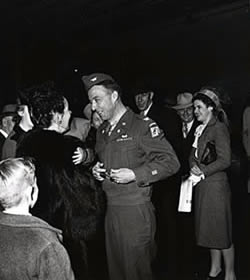
Harry P. Cain (left). During World War II, Cain (as mayor of Tacoma) received notoriety for refusing to support the internment of the Japanese. By the 1950s, however, as a U.S. Senator from Washington, he was one of the last to openly support Senator Joseph McCarthy. Cain's reactionism cost him his Senate seat, one immediately filled by Henry M. Jackson. (Special Collections, University of Washington, Portrait Files, neg. #3321.)
Economic changes during the Cold War were accompanied, almost of necessity, by political changes. A state so enmeshed in production for national security, so much a part of the country's mobilization against communism, could hardly afford to practice the left-leaning and radical-friendly politics that had characterized Washington during the 1930s. However, the state did not simply drift away from the left. Instead, during the late 1940s and early 1950s it actively tried to purge radicals and suspected radicals, former radicals and suspected former radicals, from positions of influence. Washington did not just join the other Americans' anticommunist crusade during the early Cold War; in some respects it helped to lead the events across the country that became known as the Second Red Scare. By the time that Senator Joseph McCarthy of Wisconsin lent his name to the national movement in 1950, Washington had already gone through one set of statewide anticommunist convulsions.
The Second Red Scare resulted in large part from fears of communist subversion as the United States mobilized for a lengthy confrontation with the Soviet Union. These fears—in some respects a consequence of Americans finding themselves in an entirely unprecedented global and domestic situation—were given credence by those rare instances when the U.S. government caught spies working on behalf of the enemy. The anticommunist crusade also resulted from the efforts of Republican and Democratic politicians to accuse the other party of being "soft" on communism and to demonstrate their own firmness in the face of subversive threats. Michael Reese explains (in The Cold War and Red Scare in Washington: Historical Context):
Washington Republicans made anti-communism the central theme of their 1946 campaign, charging that Democrats had "sold their soul to the Communist Party" [CP]. They concentrated their fire on Hugh DeLacy, a US Representative from Seattle who advocated friendly relations with the Soviets. Republicans asserted (quite accurately) that DeLacy was secretly a member of the CP. The accusations that Democrats aided communism, combined with a mild post-war recession, led Republicans to sweep the elections, regaining controlled of the Washington state legislature for the first time in 16 years.
Albert Canwell was one of the many Republicans whisked into the state house in the 1946 landslide. Canwell, who later described himself as a "one-man FBI," had previously worked undercover to monitor CP activities for Boeing, Washington Water Power, and the Spokane Police Department. During the 1947 legislature, he introduced a resolution to create a committee with broad powers to investigate "organizations whose membership includes communists."
[Virtually every student of the Canwell Committee now agrees that it represented an excessive and unfortunate reaction to the threat of communism, yet its chair—still alive in 1998—remains unrepentant. See Albert F. Canwell: An Oral History, interviewed by Timothy Frederick (Olympia: Washington State Oral History Program, 1997).] 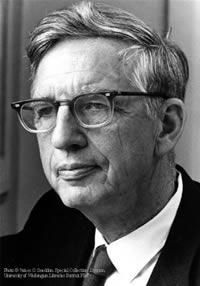
Portrait of Melvin Rader (right). (Special Collections, University of Washington, Portrait Files. Photo by James O. Sneddon, Office of Information Services.)
The bill created the Joint Fact-Finding Committee on Un-American Activities, which became known as the Canwell Committee because Albert Canwell chaired it. The Committee was authorized to conduct investigations throughout the state of Washington in order to expose "subversives," communists, and other threats to national security. One reason that it claimed such attention, of course, was that during the 1930s many in Washington had flirted with or joined the Communist Party and other radical organizations—as had numerous individuals across the country who were convinced that the Great Depression meant the capitalist system was collapsing. The committee had many targets, then, although the risk those targets actually presented to the people of Washington and the national security of the United States seems quite minuscule in retrospect. Investigations focused particularly on the seeming bastions of liberalism in the state, such as the Washington Pension Union, the Seattle Repertory Playhouse, and the University of Washington. [See Vern Countryman, Un-American Activities in the State of Washington: The Work of the Canwell Committee (Ithaca, NY: Cornell University Press, 1951 for one account.]
Many of the targets of the Canwell Committee's freewheeling "fact-finding" were damaged severely. The University, for example, fired three professors for their political affiliations, put three more on probation, and generally compromised principles of academic freedom. In firing professors, it became the first university in the United States to assert that membership in the Communist Party, in and of itself, made someone unfit to serve as a professor. [The effect of the anticommunist crusade on the U.W. is explored by Jane Sanders, Cold War on the Campus: Academic Freedom at the University of Washington, 1949-1964 (Seattle: University of Washington Press, 1979).] The Canwell committee's methods were quite haphazard. A professor of philosophy, Melvin Rader, was accused of having been a Communist during the 1930s. The accusation was false, and the committee in all likelihood had evidence that would have cleared Rader of these charges, but it did nothing with it and left Rader dangling under a cloud of suspicion until he and a newspaper reporter could clear his name. [See Melvin Rader, False Witness (Seattle: University of Washington Press, 1969; reprint, 1998) and Lorraine McConaghy, "The Seattle Times's Cold War Pulitzer Prize," Pacific Northwest Quarterly 89:1 (Winter 1997/98): 21-32.] The anticommunist crusade extended to the schools as well. A counselor for Tacoma Public Schools, Jean Schuddakopf, was fired for refusing to answer questions about her past political associations. [See Ronald E. Magden, "The Schuddakopf Case, 1954-1958: Tacoma Public Schools and Anticommunism," Pacific Northwest Quarterly 89:1 (Winter 1997/98): 4-11.] The anticommunist crusade was notably less virulent in Oregon—perhaps because Oregon had less of an economic stake in the Cold War, and perhaps because Oregon politicians and media were less mobilized about the issue. Yet in 1954 a philosophy professor at Portland's Reed College, an avowed Marxist named Stanley Moore, was fired for refusing to answer questions about his political affiliations. [See Michael Munk, "Oregon Tests Academic Freedom in (Cold) Wartime: The Reed College Trustees versus Stanley Moore," Oregon Historical Quarterly 97 (1996): 262-354; Floyd J. McKay, "After Cool Deliberation: Reed College, Oregon Editors, and the Red Scare of 1954, " Pacific Northwest Quarterly 89 (Winter 1997/98): 12-20.]
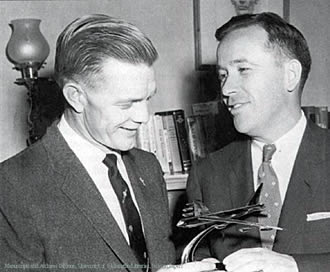
Henry M. Jackson (at right). "Senator Jackson receives a trophy from a Boeing Company representative." (Jackson Papers, Manuscripts and University Archives Division, University of Washington Libraries. Photo and caption reproduced in Richard S. Kirkendall, "Two Senators and the Boeing Company," Columbia, the Magazine of Northwest History 11 [Winter 1997-98], 39)
In the same way that the Cold War wrought long-term changes in the Washington economy, so it wrought long-term changes in the state's politics. The Second Red Scare succeeded in destroying the left in the Pacific Northwest. The Democratic Party certainly survived and remained powerful, but it was no mere coincidence that one of its two major leaders during the postwar period, Senator Henry M. Jackson, was a staunch Cold Warrior. It was no mere coincidence, in light of the growing importance of the Boeing company to the state, that the anti-corporate rhetoric that had characterized Democratic politics in the 1930s had virtually disappeared in the 1950s. Finally, it was no mere coincidence that Washington state developed increasingly strong and effective ties to Washington, D.C. in this period. The political culture of Washington—scorned by many during the 1930s as excessively leftist—had undergone substantial change. Richard S. Kirkendall, [in "Two Senators and the Boeing Company,"Columbia, the Magazine of Northwest History 11 (Winter 1997-98): 38-43] describes the transformation as one from 1930s progressivism to 1950s liberalism The effects of political and economic transition remain quite evident in today's Washington. Among the important artifacts of the Cold War are the long-lived radioactive waste at Hanford, and Seattle's signature building, the Space Needle—topics to be addressed in the next two lessons.
| Course Home | Previous Lesson | Next Lesson |